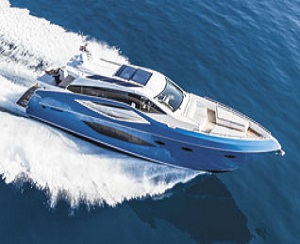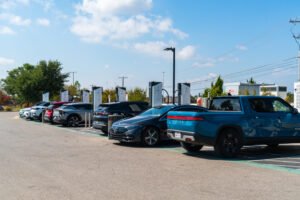Hybrid logos on the cars and SUVs on our roads today are sometimes seen as a badge of honor, a thumb in the eye of OPEC, and a pragmatic response to a hard question: How much oil does the world have left? But those vehicles are becoming a more common, and sometimes silent, sight, driven by everyone from movie stars to traveling salesmen to gearheads. They are often equipped with dashboard monitors showing occupants where power is coming from at any given moment.
Common wisdom on the highway dictates that when a hybrid coasts or brakes, the momentum of the vehicle charges the batteries, providing power that is essentially free. Not so with boats. Deriving regenerative energy from powerboats would seem to have a negative result: loss of speed and therefore efficiency. And there’s also no braking from which to capture wasted energy. Seems like a small factor, but wasted energy—energy lost in the transfer from one medium to another—is the difference between a hybrid working efficiently or not.
“Land vehicles get regeneration when they brake and coast downhill,” says Dave Gerr, naval architect, founder of Gerr Marine and director of the Westlawn Institute of Marine Technology. “And land vehicles spend an awful lot of time in traffic, at idle speed, just creeping along at two or three miles an hour. And depending on the type of hybrid system they have, they virtually shut down or truly shut down the internal combustion engine when they’re running incredibly inefficiently—there’s a tremendous saving there. Boats don’t really do any of those things ever. You can imagine some scenario where a boat that’s designed to run at 12 knots is running at two knots for long periods of time maybe would be applicable for a situation like that. But it’s really unusual. And regeneration never happens on boats, they don’t go up and down hills and they don’t brake, so you get none of the gains.”
Within the last eight years, Nordhavn built two diesel-electric boats that were classified as “complete failures” by company president Dan Streech. “We will never attempt that again during my tenure at PAE,” he said in a 2009 interview on the Nordhavn Web site. On the flip side, the Island Pilot Hybrid DSe has been racking up awards with efficient systems coupled to a photovoltaic solar-panel array and juice-generating windmills. The builder touts quiet operation and the ability to stay for months on the hook with only solar power to run accessories.
Yet companies are still trying to make hybrid propulsion work for boats with more conventional usage profiles. Just as in cars, one of the challenges is the complexity of the systems and applying them efficiently to the way prospective owners want to use them—all the more daunting considering the comparative size of the marine market. Another factor that carries over from the automotive market lays in the selling of the technology: The word “hybrid” is a very nonspecific term, and there’s more than one type of system to which it is applied.
More specifically, there are two types available to boat owners: parallel and serial (see simple diagrams of each system on page 47). A parallel system is currently available in the Mochi Craft LR23 (www.mochicraft-yacht.com) and has been for more than four years now. Boats equipped with systems from Austria-based Steyr Motors are also parallel hybrids and so are some other custom vessels. The basic idea is that you have a diesel engine that drives the propshaft but also has an electric motor that can turn it. When the diesel engine runs, it can charge the batteries, but you can also make way by shutting down the diesel and running the electric motor off the battery banks.
“Reliability is very important,” says Andrea Frabetti, product development director for Ferretti Group’s Advanced Yacht Technology. “If you have a diesel engine that is not working for some reason, you can run one engine and charge the battery, and in the meantime use the power for the other electric motor to operate the boat with two propellers but with one diesel engine on.” Aside from redundancy, other benefits include the ability to run silently and without diesel fumes.
The second system is a serial hybrid, which has a smaller diesel engine that functions exclusively as a genset—it only runs when the power supply in a battery bank drops below a certain level. That battery bank powers an electric-motor propulsion system, giving the low-end torque that makes this the system of choice for “clean” city buses. The diesel in a serial hybrid never powers anything except the genset. Serial-hybrid systems offer other advantages: The diesel always runs at optimal load, storing energy in the batteries, so it optimizes the energy in every gallon of diesel. And since it can power accessory electrical systems, such as those that operate marine electronics, a windlass or thrusters, and “hotel” systems, such as those powering interior lighting, laundry, and air conditioning, the serial hybrid eliminates the need for a separate genset, reducing weight, complexity, and up-front costs.
Northern Lights (www.northern-lights.com) announced its Hybrid Marine System at last year’s Fort Lauderdale International Boat Show, a serial-hybrid propulsion system that can be set up to run as much or as little of a boat’s electrical systems as the owner wants. The Northern Lights system means that the entire propulsion and electrical system is branded from one company. All components have one source, and can be serviced by the company’s network—not a small issue for boat owners considering cutting-edge technology.
“The real key to this equation is power on demand as opposed to power based on what you think you might need,” says Colin Puckett, director of marketing for Northern Lights. “We’re only providing power that the vessel is actually demanding, as opposed to whatever kilowatt rating the owner thinks he might possibly need when he’s got every single switch on, on the entire vessel.” Leaving it up to the system controls should mean more efficient operation. Another contributor to efficiency is the induction motor of the Hybrid Marine System, which charges the system by letting the turning prop charge the batteries when the user throttles down—a nascent form of regeneration.
Still, others are devoting energy to making marine hybrid propulsion a viable alternative to diesel and wind. The European Union Hybrid Marine Project (www.hymar.org) is a collaborative research and development project with the aim of developing systems for displacement vessels up to 80 feet or so. Nigel Calder serves as the project’s technical coordinator, and he also created a custom hybrid propulsion system on a sailing yacht in collaboration with Malö Yachts in Sweden. “Looking at efficiency in terms of fuel efficiency is really not the best metric,” argues Calder. “We should be looking at the total cost of producing energy on a boat. Hybrids can consolidate several hours of low-load running into one hour of high-load generator run time, considerably reducing overall costs. The other great benefit is the silence that accrues from reduced engine run-hours. I believe it is the potential noise reduction that will sell hybrids more than anything else.”
While hybrid efficiency may never catch up to that of a conventional diesel on a straight mile-per-gallon comparison in a marine application, closure of the efficiency gap, simplification of systems and their management, and smoke-free, silent operation could truly make these systems more likely alternatives. And maybe that quieter operation will let us hear ourselves think.






